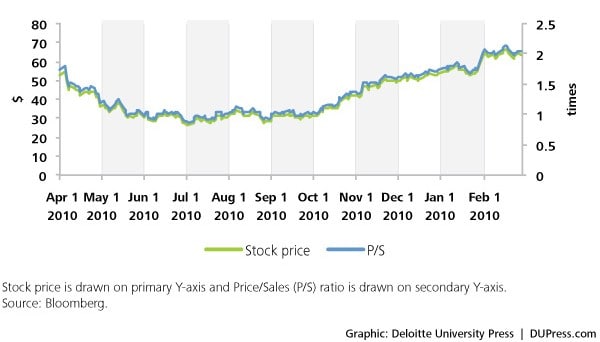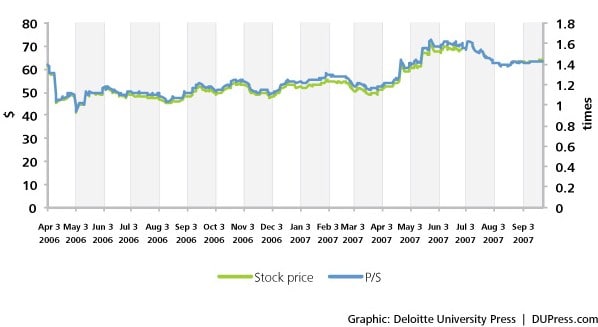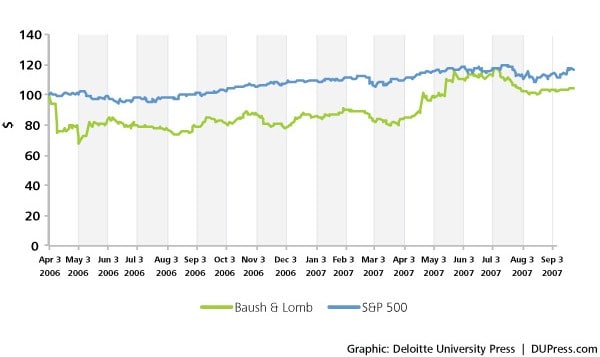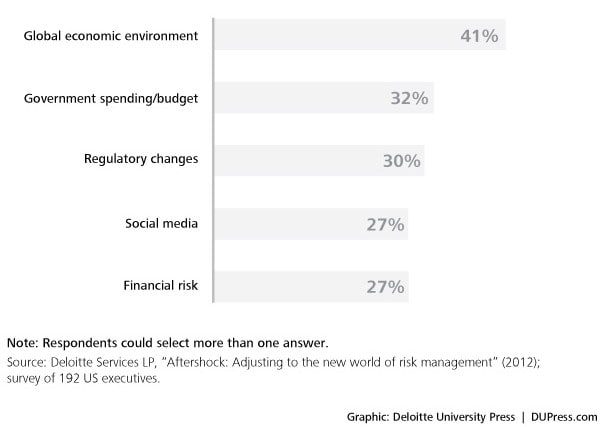Finding the value in environmental, social, and governance performance has been saved

Finding the value in environmental, social, and governance performance
31 January 2013
- Dr. Dinah A. Koehler, Eric J. Hespenheide
Not surprisingly, environmental, social, or governance issues can trigger a crisis that leads to fundamental changes in a company’s management, culture, and of course its financial health. As investors seek value from ESG, however, there is evidence that companies demonstrably prepared for these shocks can better mitigate downside risks, capture investor interest, and establish the long-term value of ESG management.
“Chance favors the prepared mind” —Louis Pasteur
We’d all like to find the pot of gold at the end of the rainbow. This is no less true in the world of sustainable investing, which seeks to leverage a company’s environmental, social, and governance (ESG) performance to identify winning stocks. To date, managers of approximately $30 trillion in financial assets—all signatories to the United Nations Principles for Responsible Investment (UN PRI)1—are trying to identify companies with higher levels of ESG performance and strong returns. For nearly all of the world’s largest publicly traded companies, reporting on ESG performance is table stakes. ESG management is on the agenda of more CFOs.Yet when questioned, many investors doubt whether that pot of gold exists, and companies are having a hard time convincing them.
These doubts have been detrimental to how much companies invest in ESG management and make it more difficult to argue for mandating disclosure of ESG metrics because they are financially material. Integration of ESG criteria into investment strategy has reached an estimated $10.7 trillion in assets under management, only about seven percent of the total global market.4 How companies approach ESG and report their performance varies greatly, and this idiosyncratic behavior only further clouds the issue. Mixed messages from the academic community do not help.
At the heart of the matter is the kind of information investors pay attention to. Our review of the evidence on investor behavior confirms that ESG issues can unleash a crisis resulting in fundamental shifts in a company’s management, culture, and financial well-being. A growing class of risks, they can be financially material and increasingly a concern in today’s growth-challenged and volatile environment, where even small shocks from the outside world can determine whether a company sinks or swims.
Those companies that are demonstrably prepared for ESG shocks can better mitigate the downside risks, both short- and long-term. This makes disclosure on how companies manage their ESG risks all the more critical, because it can help capture investor interest and establish the long-term value of ESG management.
The market value of ESG information
First things first: Is there evidence that ESG information matters to investors? Researchers have over the past 40 years examined various pathways through which ESG issues can impact company performance in multiple contexts, in emerging and developed markets, over different time periods, and as a function of both regulation and voluntary initiatives.
Indirectly or directly, ESG impacts performance
Environmental, social, and governance (ESG) issues can impact company financial performance tied directly to its operations or products, or indirectly through stakeholder actions along the entire value chain, for example:
Direct operations risk
- Accidents/spills/equipment failure
- Environmental: pollution, e.g., carbon emissions, water pollution, penalties, and fines
- Social: employee strikes, wage concerns, health and safety
Supply chain risk
- Social: child labor
- Ingredients/natural resource use, such as palm oil, old growth forest, or water
- Weather catastrophes
Product risk
- Ingredients: toxic chemicals, genetically modified organisms (GMOs)
- Product performance, recalls, boycotts
- Governance
- Board composition and independence
The strongest evidence that ESG performance impacts financial performance is found in short-term event studies, which put the spotlight on the link between ESG information and investor interest and decisions. A wide range of ESG events have been studied, including the negative impact on stock returns of corporate criminal activity, to violations of labor and environmental laws and product recalls.5 News on human rights issues associated with a company have triggered an average $892 million drop in market value, and boycotts and other forms of protest can and do impact stock prices.6 Public protests on labor and consumer issues, such as product quality, can cause a 1 percent drop in stock prices in the days around the event.7
Investor perception matters, and there are signs that it has been changing. With each decade since 1980, investors respond more to negative environmental news (1980–1989: –0.42 percent drop in stock returns; 1990–1999: –0.66 percent; 2000–2009: –1.12 percent).8 The same study finds that positive news on a company’s environmental behavior is also rewarded by an average increase in stock returns of 0.84 percent; though the positive investor response to good environmental news has been tapering off in more recent years. These trends may also be influenced by systemic biases associated with how we perceive good versus bad news; we are more risk averse when it comes to bad news, which can accentuate the outcomes of our decision-making processes. A good rule of thumb is that one negative story is the equivalent of five positive stories.9 Not surprisingly, as media coverage increases so does the drop in stock price, especially for those companies with an already tainted reputation. These companies are more likely to accede to stakeholder demands, even if their sales have not been negatively affected.10
On the upside, a positive ESG reputation adds an extra layer of protection—what we call an ESG halo.11 Companies with an ESG halo were shielded from a decline in stock price around the time of the dramatic protests that disrupted the 1999 World Trade Organization (WTO) ministerial meetings in Seattle—even if these companies operated in industries more broadly regarded as environmentally damaging and labor-abusing.12 For these reasons, ESG disclosure is valuable because it helps a company demonstrate that it is managing its risks and has a track record of paying attention to its ESG performance. Those that disclose more ESG information are more likely to enjoy a lower cost of capital according to academic research.13
Third-party recognition of a company’s ESG performance can provide a protective ESG halo—but not always. When a company was added to the Dow Jones Sustainability Index (DJSI) between 1999 and 2007—a third-party recognition for its ESG performance—stock returns increased after the announcement.14 Perhaps intuitively, companies that are dropped from the index experience a decrease in stock returns, especially if they have received negative press in the week prior to the announcement date, while for companies expected to have strong future financial performance, addition to or deletion from the DJSI has little impact on market value. But for companies where market expectations are lower, addition to the DJSI can increase market value, and deletion can drive down market value.
The empirical evidence to date most strongly suggests that:
- The average investor (not only the ESG-focused investor) is paying attention to ESG when things go wrong and the company is in the limelight and usually under duress.
- It is likely that the investor reaction to negative ESG events will continue to increase as more investors pay attention and increasingly understand what these events can mean for a company.
- Disclosure of ESG performance can partially protect against drops in shareholder value when things do go wrong.
Short-term events are one thing. It would be easier to draw a firm conclusion on the effect of strong ESG management as a driver of drive long-term returns if the evidence were clearer. Many attempts have been made to show that ESG indices outperform a benchmark index. Yet research finds that the outperformance of these indices is better explained by factors other than ESG,15 including performance of the popular KLD 400 Social and Dow Jones Sustainability Index.16 Claims of sustained outperformance of an index are inherently questionable because, if true, investors will quickly arbitrage away the effect. Two notable recent review papers suggest that past conclusions on a potential long term financial impact of ESG management should be interpreted with caution because many researchers use faulty methods or questionable data.17 Based upon a set of papers using what the researchers deem more credible methods, they find that over longer time periods ESG performance affects financial performance (both accounting measures and stock returns), but that on average the impact is minimal.
This outcome is not entirely surprising. Most companies adopt an incremental approach when they take action to improve their ESG performance, often indistinguishable from business as usual.18 Disentangling the effects of these efforts from other long-term drivers of market value is difficult.
ESG Shocks
The empirical record therefore, most strongly supports the conclusion that the value of ESG management—or lack thereof—is clearest after the fact, when the crisis has hit. ESG events can occur at any time as a short-term shock, which, if repeated, can chip away at a company’s performance or be large-scale catastrophes of the black swan variety; especially for companies already facing a tough business environment. Many have knock-on effects. An ESG event at one company can also negatively affect returns of its industry peers.19 Large-scale events, such as explosions and spills, can trigger an industry wide paradigm shift. For example, the 1984 Bhopal chemical accident resulted in the US Emergency Planning and Community Right-to-Know Act (EPCRA)—including mandated reporting of toxic chemicals to the EPA’s toxic chemicals inventory (TRI), the chemical industry’s Responsible Care program, and widespread scrutiny of chemicals emissions by investors, advocacy groups, and academics.
On April 5, 2010, there was an explosion at Massey Energy’s Upper Big Branch mine in Montcoal, West Virginia, killing 29 miners. At that time, Massey Energy was the fourth largest producer of coal in the United States and the largest coal producer in Central Appalachia. The stock fell 11 percent on April 6, and by the end of April was down by 33 percent (see figure 1)20. Facing estimated costs between $80–$150 million to compensate the families of the fallen miners and pay insurance deductibles and possible legal fees, as well as about $62 million worth of equipment and mineral rights impacted by the disaster, Massey’s financial performance deteriorated rapidly. As evidence of a poor safety record was unearthed, pressure on senior management increased, leading the CEO Don Blankenship to retire in December 2010. On January 28, 2011, shareholders of Alpha Natural Resources—known for a focus on safety—agreed to buy Massey Energy for $7.1 billion, and the stock price jumped 10 percent. The Massey accident brought the consequences of shortchanging safety for the sake of profit to the fore in the coal mining industry, which has since been in decline due to cheap natural gas and increased regulation.21
Figure 1. Massey Energy mining accident: Impact on stock price and price/sales ratio
Figure 2. Bausch & Lomb product recalls: impact on stock price and price/sales ratio
Figure 3. Bausch & Lomb performance relative to S&P 500
Product recalls are also significant events in the life of a company, often associated with brand and reputation loss and multimillion dollar law suits. For example, in May 2006 Bausch & Lomb issued a worldwide product recall of ReNu with Moisture Loc contact lens solution due to fungal infections in user eyes. The market appeared to be aware of the problem in April and the stock fell 28%. Within weeks, the company's US market share for lens solutions dropped to 29 percent, down from 41 percent, and was rapidly snatched up by its competitors—pushing down Bausch & Lomb price/sales ratio. A well-known 156-year-old Rochester-based company with 2006 sales of $2.3 billion, Bausch & Lomb issued another recall in March 2007, this time of ReNu MultiPlus contact lens solution. The stock price continued to underperform the S&P 500 for an extended time period, see figures 2 and 3. Under pressure from two product recalls, tough competition, rising litigation costs, and accounting restatements, Bausch & Lomb was sold to Warburg Pincus in May 2007. Shares rose again (36%) between March 16, 2007 and May 16, 2007 on speculation that the company could be a target of a leveraged buy-out.22 Thus, while the company faced several challenges, the product recall triggered a significant immediate drop in stock price followed by a sustained period of underperformance.
Why focus on catastrophes? They serve as an important point of reference for those managers intent on building a more resilient company. These worst-case scenarios—where a company can simultaneously face several headwinds, including an ESG event—have several things in common: a significant drop in stock price after the ESG event (over 25 percent), a sustained period of underperformance, poor post-event management and reputation loss, negative brand exposure in the media, senior management turnover, lack of effective communication, increased regulatory activity, and quite often, takeover. Empirical research generally finds that catastrophes from which companies have difficulty recovering are marked by the following:23
- An initial negative response of over 10 percent of market capitalization and significant financial loss in the first two or three months after the event
- A large number of fatalities
- Sustained underperformance based on management response to the catastrophe.
The latter point is revealing in that quite often the direct losses associated with catastrophes are dwarfed by investor loss of confidence in management’s ability to deal with the situation and its aftermath. This need not always be the case according to Daniel Diermeier.24 He has argued that those management teams that quickly shift from crisis management (emphasizing containment and solution) to managing the risk of future events can more rapidly recover from a crisis. The key is the realization that what underlie many of these crises—and resulting large shareholder value shifts—are a company’s strategy, execution of core business processes, and whether it is adapting to changes in the business environment, and not merely operational or financial risks.25 According to Andre Abadie, managing director at JP Morgan, “Companies can implement safeguards to minimize the impact of operational risks. They have greater difficulty managing their strategic risks, which are driven by macro shifts in the business environment.”26 ESG events can trigger a shift in the business environment requiring a strategic rethink and enhanced risk assessment.
Risky business
ESG issues are particularly vexing because they can arise anywhere in a company’s value chain. Many ESG risks—labor protests and safety concerns or ecosystem damage—are embedded in vast corporate supply chains, where they are getting more attention.27 Activists often target similar companies or popular brands because they have a strategic vulnerability to the supplier. For many companies, these are reputation risks—guilt by association—rather than direct operations or financial risks. However, the risks cannot simply be outsourced.28
For several reasons, we believe ESG risks will increasingly impact financial performance. First, investors seem to be paying more attention to ESG information, evidenced by an increasingly steeper drop in stock price around such an event. Second, volatility in the global business environment due to financial risks, regulatory uncertainty, extreme weather (e.g., flooding in Thailand as this is being written), rising business interruption premiums,29 crop failures, commodity price volatility, and social unrest means that what seem to be black swans are more likely than previously thought.
Third, today’s lean supply chains are often more brittle and vulnerable to disruption because supply chain managers tend to focus on efficiency, in many cases without fully understanding the consequences of reduced redundancy and flexibility. When they occur, supply chain disruptions can have longer-term financial consequences similar to the ESG events described above.30
And fourth, the rise of social media and private politics—where nonregulatory agents push an agenda—is beginning to rival the impact of public politics and regulatory processes, including those addressing ESG issues (see figure 4). Social media speed up and complicate the entire news cycle on a global scale. While traditional high-profile news media are typically still the first to report a new story, it is the dynamic blogosphere that may pick up the story within a few hours and discuss it at length, which prolongs the focus on a company’s shortcomings.31 In this way, ESG issues can gain momentum on social media and continue to erode corporate reputations and investor confidence in corporate management.
Figure 4. Most important risk sources in the next three years (top five)
Leveraging ESG Information
“Managers need to understand the latent risks embedded in their company’s business model before they become a full-blown risk,” according to Bruno Bertocci, managing director and global equity portfolio manager at UBS Global Asset Management.32 He adds that investors focus on management’s preparedness for the unknown, for volatility, and its ability to execute a business strategy without incurring too much risk—which requires a better understanding of all aspects of the business.
“ESG is a proxy for risk that is not priced in, and companies that better manage these risks can deliver returns with greater certainty,” according to Dan Hanson, managing director at BlackRock.33 For example, investment in stakeholder engagement pays off as a preventive strategy and can mitigate ESG shocks when they occur. This is underscored by research in the gold mining industry. Mines with better engagement with the local community and government enjoy a significantly lower discount rate than mines with contentious stakeholder relations because they have typically experienced a higher success rate of extracting the gold.34
There are three implications for managers arising from this research. First, a record of ESG disclosure matters because it can help mitigate the immediate impact of an ESG shock when it occurs. Second, the severity of an ESG shock depends in large part on post event management, and the duration of the shock often hinges on long-term changes that a company implements to minimize the risks of future ESG events.
This leads to the third implication and opportunity: To increase and maintain investor confidence, managers need to show how they are prepared to respond to ESG shocks and prevent them from turning into a longer-term problem. This means disclosure of ESG outputs (e.g., reporting of emissions) and clearer explanation of how ESG risks—the often unintended consequences of various ESG outputs—are identified, assessed in terms of their materiality to business value,35 and managed. Historical information on ESG outputs matters because it can be predictive of future consequences. For example, the risk of costly chemical accidents increases at facilities that emit more toxic chemicals.36 When reporting on climate change, greenhouse gas (GHG) emissions are only part of the story, indicative of regulatory risk and a potential price on carbon. The issue for many companies is whether they are adapting to the consequences for their business of higher GHG concentrations in the atmosphere, such as higher insurance premiums, business interruption and property damage.
The pot of gold analogy, therefore, is more nuanced than many observers would like. Companies that factor ESG risks into their planning, and manage accordingly, have the potential to fare better and lend credence after all to the notion of ESG performance as worthy of market recognition. To capture value derived from ESG management, corporate leaders can demonstrate to their investors how they are getting ahead of ESG risks in their day-to-day management and building resilience before the next ESG shock. This may entail strategic rethinking of the business, including new product innovation, business model changes, and other steps to increase profitability. While this is a narrative of crisis and aftermath, a closer look at ESG by the numbers suggests that it is a lens through which business leaders can build better, more resilient, and more valuable enterprises.
© 2021. See Terms of Use for more information.





